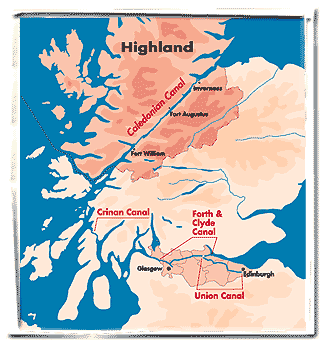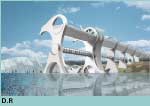| |
The main partner of the VEV project in Scotland is The Highland
Council. This region is crossed from east to west, through the
"Great Glen", by the Caledonian Canal.
This canal, 96.5 km long, was built at the beginning of the 19th
century to encourage trade in coasters between the East coast
ports and those of the West coast, as well as the islands.
This is why the capacity is remarkably large for the period, with
locks 45.70m long, 10.70m wide, and a depth over sills of 4.10m.
All the bridges were movable (mainly swing bridges).
The waterway crosses Lochs Ness, Oich and Lochy over a distance
of 62km. The remaining 34.5 km are man-made canal sections, with
29 locks.
The Highland Council approved a proposal by British Waterways
to include in the project the other Scottish waterways managed
and operated by the national body.
The Crinan Canal, 14,5km long, cuts the isthmus of the Mull of
Kintyre, thus offering a route no less than 135km shorter for
boats serving the islands from the port of Glasgow. It comprises
15 locks, more modest in size than those of Caledonian: 26.80
m long, 6.10m wide and a draught of 2.90m. The principal issues
of development of this canal relate to the ports located at each
end, Crinan on the western side facing the islands, and Ardrishaig
to the east.

It
is between Scotland's capital Edinburgh and the historic centre
of commerce and industry, Glasgow, supported by a major seaport
in the Clyde estuary, that one of Europe's most ambitious projects
for restoration of an abandoned inland waterway is currently being
carried out. It is the Millennium Link, made up of two canals :
-
the Forth & Clyde Canal, with locks 20.90 m long, 6.00 m wide
and 2.60 m deep, and a headroom of more than 20 m.
- the
Union Canal, capacity 20.10 m by 3,40 m, headroom of 1,50 m
and a draught of 1,05 m,
- and
the connection under construction between the two, close to
the town of Falkirk.

|
|



